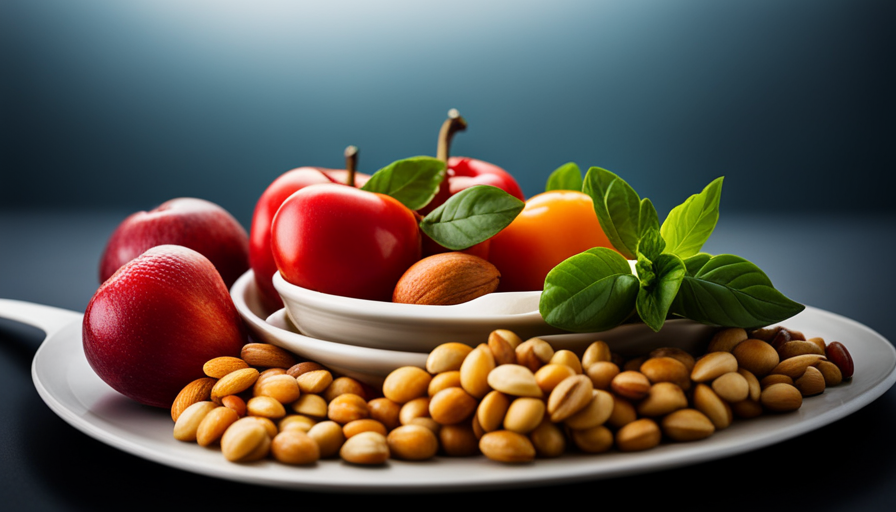Ever thought about the culinary world’s hidden gem? You’re in luck as I explore the intriguing world of raw beef dishes. Get ready for an exciting exploration into the vocabulary, cultural importance, cooking techniques, worldwide popularity, health aspects, moral consequences, as well as its appearance in mainstream media and traditional healing practices.
From tartare to carpaccio, this article will leave no stone unturned in exploring the delectable world of raw beef. As a passionate food enthusiast, I aim to provide you with a precise, informative, and technical perspective on this culinary phenomenon.
So, fasten your seatbelts and get ready to embark on an adventure that will not only expand your gastronomic knowledge but also inspire you to explore the possibilities of raw beef in your own kitchen. Let’s get cooking!
Key Takeaways
- Raw beef dishes have various names globally, including beef tartare, yukhoe, gyu sashimi, and carpaccio.
- Raw beef is a popular ingredient in contemporary and fusion cuisine, offering unique flavors and textures.
- Consumption of raw beef carries a risk of bacterial contamination, so proper food safety guidelines should be followed.
- Raw beef dishes are often associated with luxury and fine dining experiences, symbolizing indulgence and exclusivity.
Understanding the Terminology
If you’re not familiar with the culinary world, you might be wondering, ‘What do you call raw beef food?’ Well, the term commonly used to refer to raw beef is ‘beef tartare.’ This dish originated in France and has since gained popularity worldwide. It is made by finely chopping or grinding high-quality beef and seasoning it with various ingredients like onions, capers, Worcestershire sauce, and raw egg yolk. The result is a flavorful and tender raw beef dish that is enjoyed by many.
Now, let’s talk about the cultural influences and nutritional value of beef tartare. This dish has been influenced by various cultures, each adding their own unique twist to the recipe. For example, in Asian cuisine, raw beef dishes like ‘yukhoe’ and ‘gyu sashimi’ are popular. These dishes often incorporate soy sauce and sesame oil for added flavor.
In terms of nutritional value, beef tartare is a great source of high-quality protein, essential amino acids, vitamins, and minerals. However, it’s important to note that consuming raw beef carries a risk of bacterial contamination, so it’s crucial to use fresh, high-quality meat and follow proper food safety guidelines.
Moving on to the cultural significance of raw beef, it holds a special place in many culinary traditions. It’s often associated with luxury and indulgence, making it a popular choice for special occasions and fine dining experiences.
So, now that we understand what raw beef food is and its cultural significance, let’s delve deeper into its preparation and variations.
Cultural Significance of Raw Beef
Indulge in the rich cultural heritage of savoring uncooked cuts of beef, a culinary practice celebrated by many across the globe. Raw beef holds a significant place in various cultural traditions, where it’s considered a delicacy and a symbol of prestige.
In Japan, for example, the consumption of raw beef, known as ‘beef sashimi’ or ‘gyuuniku no sashimi,’ is deeply rooted in their food culture. This tradition showcases the skill and expertise of the chef in selecting the finest quality beef and preparing it with precision.
Aside from its cultural significance, raw beef also offers nutritional benefits. It’s a valuable source of high-quality protein, essential amino acids, vitamins, and minerals. Raw beef is particularly rich in iron, which plays a crucial role in oxygen transportation and energy production. Additionally, it contains vitamin B12, which supports nerve function and the production of red blood cells.
Transitioning into the subsequent section about preparation methods, various techniques are used to enhance the flavor and texture of raw beef. These methods include marinating the meat in soy sauce, garlic, and ginger, or lightly searing it to add a subtle smoky taste. By understanding the cultural significance and nutritional benefits of raw beef, we can appreciate the artistry behind its preparation methods.
Preparation Methods
Get ready to tantalize your taste buds with the various preparation methods that add flavor and finesse to your uncooked beef cuts! When it comes to raw beef, understanding the cuts and choosing the best seasoning options can make all the difference.
Here are some techniques to enhance the taste and texture of your raw beef:
-
Carpaccio: Thinly sliced beef, often seasoned with olive oil, lemon juice, and Parmesan cheese, for a delicate and refreshing dish.
-
Tartare: Finely chopped beef mixed with ingredients like onions, capers, and Worcestershire sauce, offering a flavorful and zesty experience.
-
Beef Ceviche: Marinating raw beef in citrus juices like lime or lemon, along with spices and herbs, resulting in a tangy and vibrant dish.
-
Korean Yukhoe: Marinated raw beef, usually with soy sauce, sesame oil, and garlic, creating a savory and rich flavor profile.
Understanding the cuts of beef is essential for these preparations. Different cuts, such as tenderloin or ribeye, offer varying textures and flavors. Additionally, choosing the best seasoning options, like fresh herbs or quality spices, can elevate the taste even further.
As we explore the global consumption of raw beef, we’ll delve into the cultural significance and unique dishes from around the world.
Global Consumption of Raw Beef
Exploring the global culinary landscape reveals a captivating array of cultural traditions and culinary masterpieces involving the consumption of raw beef. Raw beef dishes are enjoyed in various countries around the world, each with its own unique preparation and presentation.
In Japan, for example, raw beef is thinly sliced and served as part of a dish called ‘Yukhoe,’ which is often enjoyed with a raw egg yolk on top.
In South America, particularly in countries like Argentina and Brazil, raw beef is commonly used to make a dish called ‘Carpaccio,’ where the meat is thinly sliced and served with a drizzle of olive oil and lemon juice.
Despite its popularity, the consumption of raw beef does come with some health risks. Raw beef can be contaminated with bacteria such as Salmonella, E.coli, and Listeria, which can cause foodborne illnesses. Therefore, it’s crucial to ensure that the beef used for raw consumption is fresh and sourced from reputable suppliers. Additionally, it’s important to handle and store raw beef properly, keeping it at the right temperature to prevent the growth of harmful bacteria.
Moving into the subsequent section about health and safety considerations, it’s essential to understand the precautions and guidelines necessary for safely consuming raw beef.
Health and Safety Considerations
To ensure your safety, it’s crucial to understand the necessary precautions and guidelines when consuming raw beef. Raw beef safety should be a top priority, as there are potential health considerations to keep in mind. Here are some important points to remember:
-
Choose high-quality, fresh beef from a trusted source to minimize the risk of contamination.
-
Keep raw beef refrigerated at temperatures below 40°F (4°C) to inhibit the growth of harmful bacteria.
-
Use separate cutting boards, utensils, and surfaces for raw beef to prevent cross-contamination with other foods.
-
Thoroughly clean and sanitize all equipment and surfaces that come into contact with raw beef to eliminate any potential pathogens.
-
Cook ground beef to an internal temperature of 160°F (71°C) to ensure that any bacteria present in the meat are killed.
By following these raw beef safety guidelines, you can minimize the risk of foodborne illnesses associated with consuming raw beef.
Now, let’s explore the exciting culinary trends and innovations in the world of raw beef dishes.
Culinary Trends and Innovations
In contemporary cuisine, raw beef has become a popular ingredient, adding a unique and adventurous element to dishes.
Fusion dishes, combining different culinary traditions, have also seen a rise in popularity, and raw beef is often incorporated in these creative combinations.
Chefs are constantly finding innovative ways to use raw beef, from tartare to carpaccio, showcasing its versatility and enhancing the dining experience.
Raw beef in contemporary cuisine
Craving a tender and flavorful dish? Try sinking your teeth into some deliciously marbled raw beef, a popular choice in contemporary cuisine.
Raw beef dishes have gained popularity in fine dining establishments, offering a unique and sophisticated experience for adventurous food enthusiasts. Chefs carefully select high-quality cuts of beef, ensuring the meat is fresh and safe for consumption. The raw beef is typically thinly sliced and served with accompaniments such as pickled vegetables, soy sauce, and wasabi to enhance the flavors. The rich and buttery texture of raw beef provides a melt-in-your-mouth sensation that’s truly divine.
Additionally, fusion dishes and creative uses of raw beef have emerged, showcasing the versatility of this ingredient in various cuisines.
Transitioning into the subsequent section, let’s explore the innovative ways chefs are incorporating raw beef into fusion dishes and pushing culinary boundaries.
Fusion dishes and creative uses of raw beef
Get ready to tantalize your taste buds with the innovative and daring ways chefs are blending flavors and textures by incorporating raw beef into fusion dishes. The creative presentation of raw beef in contemporary cuisine knows no bounds. From classic tartare to Asian-inspired carpaccio, the possibilities are endless. Chefs around the world are pushing the boundaries of traditional culinary practices, experimenting with cultural variations and incorporating unique ingredients to create dishes that are as visually stunning as they are delicious. To give you a taste of the exciting world of raw beef fusion dishes, here is a table showcasing five mouth-watering creations from different culinary traditions:
| Fusion Dish | Description |
|---|---|
| Beef Sashimi | Thinly sliced raw beef served with soy sauce and wasabi. |
| Beef Carpaccio Tacos | Raw beef slices topped with avocado, salsa, and lime in a crispy tortilla shell. |
| Korean Beef Tartare | Raw beef mixed with Korean spices, sesame oil, and served with rice crackers. |
| Italian Beef Ceviche | Raw beef marinated in citrus juices, olive oil, and mixed with capers and red onions. |
| Thai Beef Larb Salad | Minced raw beef mixed with Thai herbs, lime juice, and chili, served with lettuce cups. |
As we explore the creative uses of raw beef, it’s important to consider the ethical and environmental implications of consuming this ingredient.
Ethical and Environmental Implications
Consuming raw beef, also known as steak tartare, has both ethical and environmental implications.
Ethical sourcing is a crucial factor to consider when it comes to raw beef consumption. It’s important to ensure that the beef is sourced from animals that’ve been raised in humane conditions, without the use of hormones or antibiotics.
Additionally, the carbon footprint associated with beef production is significant. It takes approximately 2,500 gallons of water to produce just one pound of beef, contributing to water scarcity concerns and environmental degradation.
To address these concerns, consumers can choose to support local farmers who prioritize ethical practices and sustainable farming methods. By doing so, they can minimize the environmental impact of their food choices and promote the well-being of animals.
Furthermore, reducing meat consumption overall, whether raw or cooked, can have a positive impact on the environment by reducing greenhouse gas emissions and conserving resources.
Transitioning to the subsequent section about raw beef in popular culture, it’s interesting to explore the various creative dishes and cultural influences that’ve popularized raw beef consumption.
Raw Beef in Popular Culture
In movies and literature, the portrayal of raw beef often evokes a sense of indulgence and luxury. It is often depicted as a symbol of decadence and sophistication, with characters enjoying the finest cuts of raw beef in high-end restaurants or as part of lavish meals.
This portrayal highlights the idea that consuming raw beef is an extravagant and exclusive experience, reserved for those who can afford it.
Portrayal of raw beef in movies and literature
Imagine yourself sitting in a dark theater, captivated by the vivid depiction of raw beef in movies and literature. The portrayal of raw beef in art and literature has been a subject of fascination for centuries.
It is often used as a symbol of rawness, vitality, and even danger. In movies, raw beef is often shown in close-up shots, emphasizing its texture and color to evoke strong emotions in the audience. In literature, authors use raw beef as a metaphor to represent the primal instincts and desires of human nature.
The symbolism of raw beef in literature can be seen as a reflection of our own raw, untamed selves. As we delve into the next section about raw beef as a symbol of luxury and indulgence, we will explore how this provocative imagery is used to convey a different meaning.
Raw beef as a symbol of luxury and indulgence
Revel in the opulence and decadence that raw beef embodies, a symbol of lavishness and self-indulgence. Raw beef, in the realm of luxury dining, has become synonymous with exclusivity and sophistication. Its cultural symbolism is rooted in the idea of indulging in the finest culinary experiences.
Here are four reasons why raw beef is considered a luxurious delicacy:
-
Exquisite marbling: The intricate patterns of fat throughout the meat create a melt-in-your-mouth texture that is unrivaled in its richness.
-
Intense flavor: Raw beef offers a depth of flavor that’s both bold and nuanced, tantalizing the taste buds with every bite.
-
Rare and sought-after cuts: Delicacies like Wagyu beef, with its exceptional tenderness and buttery texture, command high prices and are reserved for special occasions.
-
Exclusivity and prestige: The consumption of raw beef is often associated with high-end restaurants and elite social circles, adding an air of exclusivity to the dining experience.
Indulging in raw beef is a luxurious affair that transcends mere sustenance. It’s a testament to one’s appreciation for the finer things in life.
Transitioning into the next section about ‘raw beef in traditional medicine,’ we delve into its historical significance beyond culinary indulgence.
Raw Beef in Traditional Medicine
Contrary to popular belief, consuming raw beef as part of traditional medicine is believed to have potential health benefits. In various cultures, raw beef has been used for centuries as a remedy for certain ailments and to promote overall well-being. Raw beef is considered a rich source of essential nutrients such as protein, iron, and B vitamins, which are important for maintaining a healthy body.
In traditional medicine, raw beef is often prepared in the form of special recipes that are believed to enhance its medicinal properties. One such recipe is called "beef tartare," which combines finely minced raw beef with ingredients like onions, capers, and Worcestershire sauce. This dish is known for its rich flavor and is often served as an appetizer.
To give you a visual representation of the potential health benefits of raw beef, here is a table showcasing some of its nutritional content:
| Nutrient | Amount per 100g | Benefits |
|---|---|---|
| Protein | 26g | Supports muscle growth |
| Iron | 2.9mg | Helps in oxygen transport |
| Vitamin B12 | 2.4µg | Essential for nerve function |
Exploring raw beef in your own kitchen allows you to discover its unique flavors and potential health benefits. By incorporating raw beef into your diet, you can explore the various recipes and experience the potential positive effects on your well-being.
Exploring Raw Beef in Your Own Kitchen
Get ready to embark on a culinary adventure in your own kitchen and discover the endless possibilities of incorporating raw beef into your meals! Understanding flavors and raw beef preparation techniques will help you create delicious and nutritious dishes.
When it comes to flavors, raw beef offers a unique taste that’s often described as rich and earthy. It’s important to choose high-quality beef from a trusted source to ensure safety and taste. Different cuts of beef can vary in flavor, so experiment with different options to find your favorite.
Before preparing raw beef, it’s essential to follow proper food safety guidelines. Start by selecting fresh, high-quality cuts and make sure they’re properly stored and handled. It’s recommended to freeze the beef for a few days to kill any potential parasites.
When it comes to preparation techniques, there are several options to consider. One popular method is to thinly slice the beef and serve it as carpaccio or tartare. Another option is to marinate the beef to enhance the flavors and tenderize the meat. You can also grind the beef to make homemade beef tartare or use it in sushi rolls.
As you explore the world of raw beef in your kitchen, remember to prioritize food safety and experiment with different flavors and preparation techniques. Enjoy the journey of creating delicious and nutrient-rich meals with this versatile ingredient!
Frequently Asked Questions
Can you provide a step-by-step guide on how to properly prepare raw beef?
Preparing raw beef requires careful attention to safety and proper techniques. To begin, make sure your work area is clean and sanitized, like a spotless surgical theater.
Next, select fresh, high-quality beef and handle it with clean hands, treating it like a precious gem.
Follow a step-by-step guide, such as marinating, seasoning, and cooking to the desired doneness.
Always prioritize raw beef safety by avoiding cross-contamination and using a food thermometer to ensure proper cooking temperatures are reached.
What are the potential health risks associated with consuming raw beef?
There are potential hazards and food safety concerns associated with consuming raw beef. Raw beef can contain harmful bacteria such as E. coli and Salmonella, which can cause foodborne illnesses. These bacteria can lead to symptoms like diarrhea, abdominal pain, and vomiting.
To minimize the risk, it’s important to handle and prepare raw beef properly, ensuring thorough cooking to kill any bacteria present. This helps to ensure the safety of the food and prevent potential health risks.
Are there any specific cultural rituals or traditions surrounding the consumption of raw beef?
Raw beef is a culinary delicacy in certain cultures, with rich cultural significance and deep-rooted traditions. It is often featured in traditional dishes, symbolizing purity and strength. From the vibrant tartare of France to the robust carpaccio of Italy, the consumption of raw beef is steeped in history and ritual.
These cultural practices celebrate the natural flavors and textures of raw beef, showcasing its place at the heart of culinary traditions around the world.
How does the global consumption of raw beef vary across different regions or countries?
Global trends in the consumption of raw beef vary across different regions and countries due to dietary preferences.
In some cultures, such as Japan, raw beef is commonly eaten in dishes like beef sashimi or steak tartare. However, in many other parts of the world, the consumption of raw beef is less common or even considered unsafe due to the risk of foodborne illnesses.
Factors such as cultural traditions, culinary practices, and food safety regulations influence the global consumption of raw beef.
Are there any legal or ethical considerations when it comes to sourcing and consuming raw beef?
There are several legal regulations and ethical concerns when it comes to sourcing and consuming raw beef. From a legal perspective, it’s important to ensure that the beef is sourced from reputable suppliers that follow proper food safety guidelines.
Additionally, there may be specific regulations regarding the labeling and handling of raw beef products.
Ethically, there are concerns about animal welfare and the potential risk of foodborne illnesses associated with consuming raw beef.
It’s crucial to consider these factors when deciding to consume raw beef.
Is Raw Beef Considered a Raw Food Item in Inventory?
Yes, raw beef is considered a raw food item in inventory according to the raw food inventory definition. It is uncooked and has not been processed, making it a crucial component in tracking and managing food stock. Proper storage and handling of raw beef are essential to prevent contamination and ensure food safety.
Conclusion
In conclusion, raw beef, also known as beef tartare or steak tartare, is a delicacy enjoyed by many cultures around the world. Its preparation methods vary, from finely minced with seasonings to thinly sliced and marinated.
While it’s important to consider health and safety precautions when consuming raw beef, the ethically and environmentally conscious can explore alternatives such as plant-based options.
Whether it’s in traditional medicine or popular culture, raw beef continues to captivate our senses and inspire culinary creativity. So why not embark on your own gastronomic adventure and explore the world of raw beef in your own kitchen?










